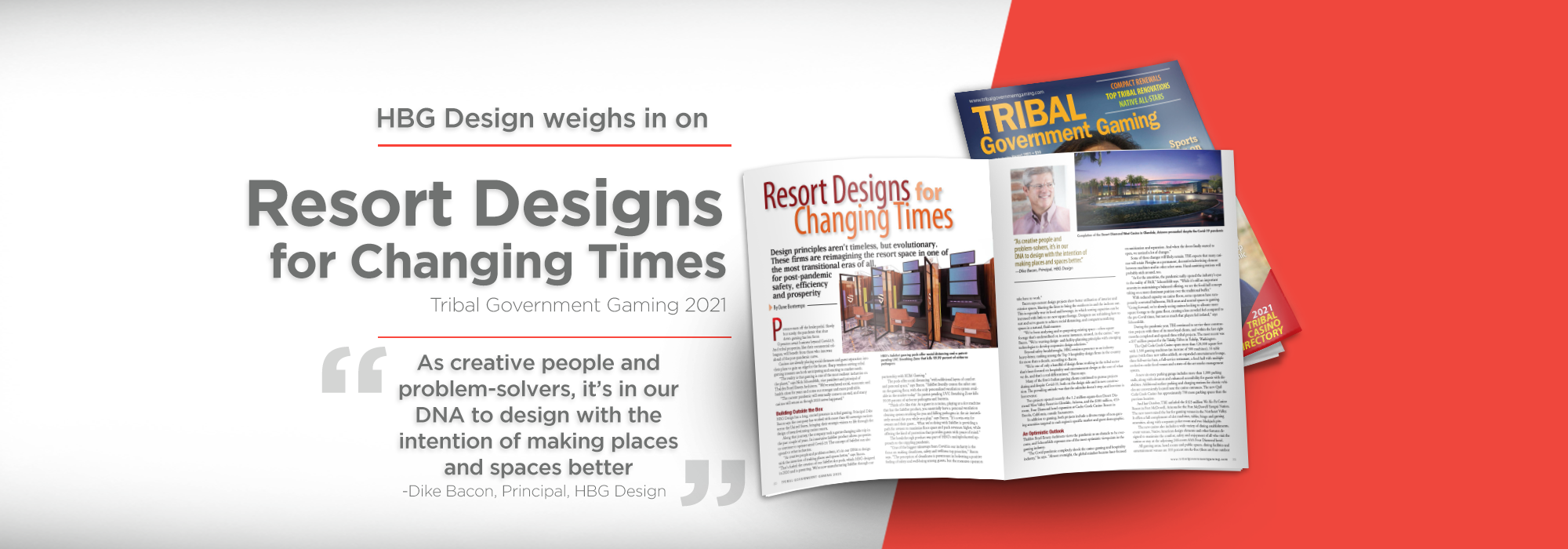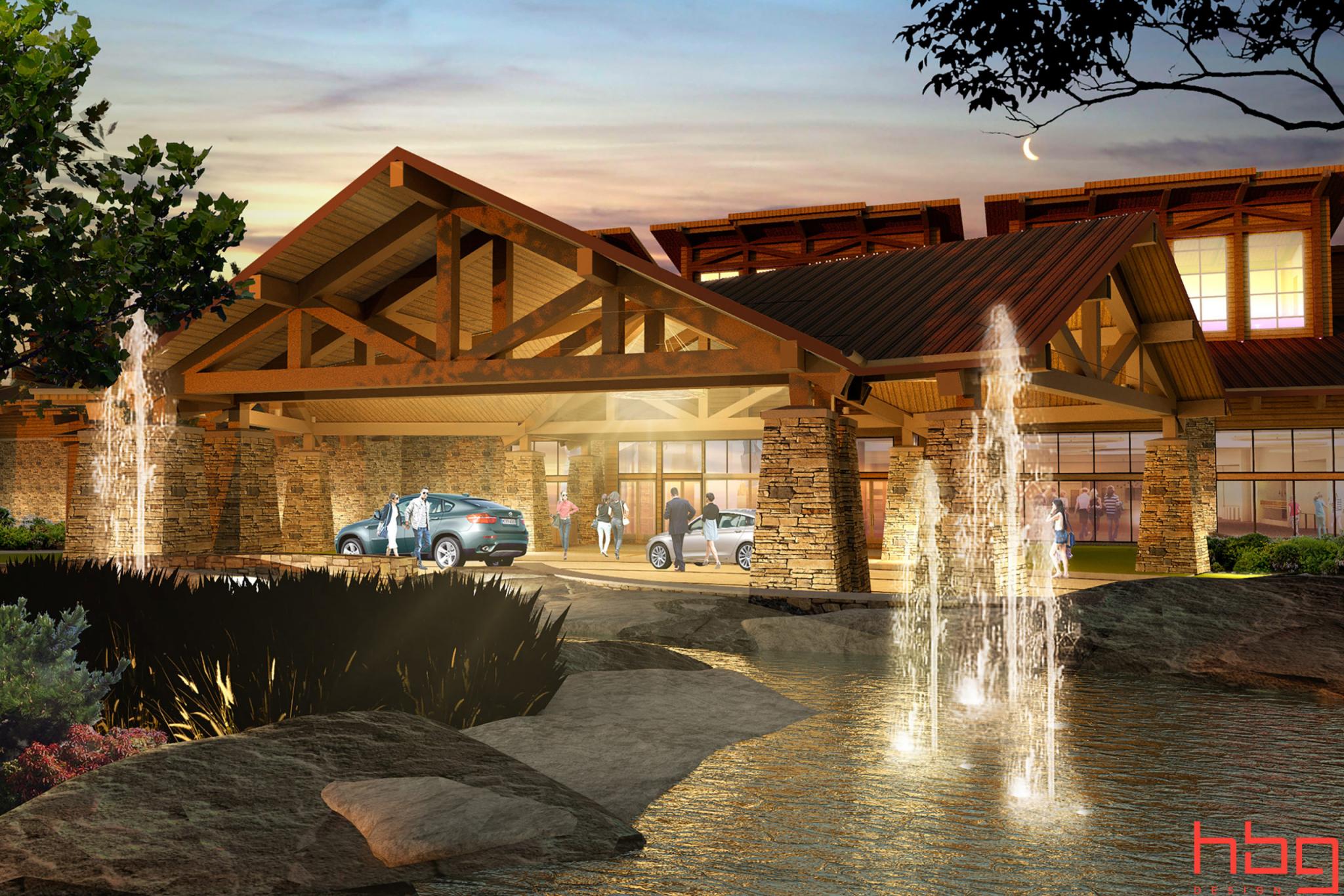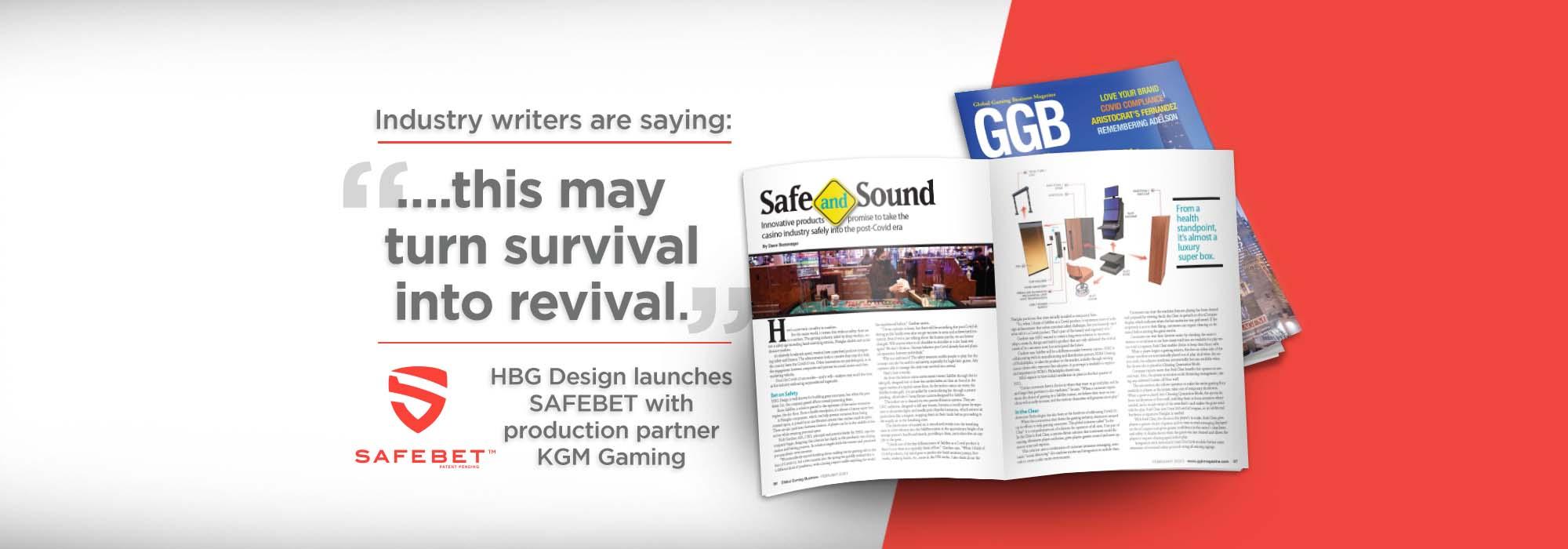HBG Design Shares Resort Designs for Changing Times in Tribal Government Gaming
https://issuu.com/globalgamingbusiness/docs/tribal_government_gaming__2021/30
Pressure eases off the brake pedal. Slowly but surely, the pandemic that shut down gaming has less force.
Operators await business beyond Covid-19. And tribal properties, like their commercial colleagues, will benefit from those who innovate ahead of the post-pandemic curve.
Casinos are already placing social distances and guest separation into their plans to gain an edge for the future. Sharp vendors serving tribal gaming interests are both anticipating and reacting to market needs.
Building Outside the Box
HBG Design has a long, storied presence in tribal gaming. Principal Dike Bacon says the company has worked with more than 40 sovereign nations across the United States, bringing their strategic visions to life through the design of award-winning casino resorts.
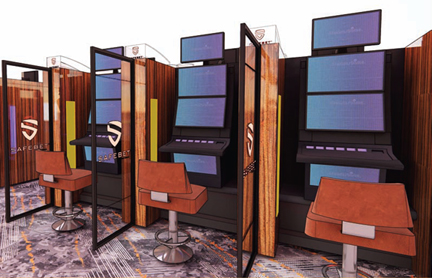
HBG’s SafeBet gaming pods offer social distancing and a patentpending UVC Breathing Zone that kills 99.99 percent of airborne pathogens
Along that journey, the company took a game-changing side trip in the past couple of years. Its innovative SafeBet product allows properties to continue to operate amid Covid-19. The concept of SafeBet can also spread to other industries.
“As creative people and problem-solvers, it’s in our DNA to design with the intention of making places and spaces better,” says Bacon. “That’s fueled the creation of our SafeBet slot pods, which HBG designed in 2020 and is patenting. We’re now manufacturing SafeBet through our partnership with KGM Gaming.”
The pods offer social distancing “with additional layers of comfort and personal space,” says Bacon. “SafeBet literally creates the safest seat on the gaming floor, with the only personalized ventilation system available in the market today.” Its patent-pending UVC Breathing Zone kills 99.99 percent of airborne pathogens and bacteria.
“Think of it like this: As a guest in a casino, playing at a slot machine that has the SafeBet product, you essentially have a personal ventilation cleaning system working for you and killing pathogens in the air immediately around the you while you play,” says Bacon. “It’s a win-win for owners and their guest… What we’re doing with SafeBet is providing a path for owners to maximize floor space and push revenues higher, while offering the kind of protection that provides guests with peace of mind.”
The breakthrough product was part of HBG’s multiple-faceted approach to the crippling pandemic.
“One of the biggest takeaways from Covid in our industry is the focus on making cleanliness, safety and wellness top priorities,” Bacon says. “The perception of cleanliness is paramount in bolstering a positive feeling of safety and well-being among guests, but the measures operators take have to work.”
Bacon says current design projects show better utilization of interior and exterior spaces, blurring the lines to bring the outdoors in and the indoors out. This is especially true in food and beverage, in which seating capacities can be increased with little to no new square footage. Designers are rethinking how to seat and serve guests to achieve social distancing, and compartmentalizing spaces in a natural, fluid manner.
“We’ve been analyzing and re-purposing existing space—often square footage that’s underutilized or, in some instances, unused, in the casino,” says Bacon. “We’re weaving design- and facility-planning principles with emerging technologies to develop responsive design solutions.”
Beyond safety breakthroughs, HBG retains a presence as an industry heavy-hitter, ranking among the Top 5 hospitality design firms in the country for more than a decade, according to Bacon.
“We’re one of only a handful of design firms working in the tribal sector that’s laser-focused on hospitality and entertainment design as the core of what we do, and that’s a real differentiator,” Bacon says.
Many of the firm’s Indian gaming clients continued to pursue projects during and despite Covid-19, both on the design side and in new construction. The prevailing attitude was that the calendar doesn’t stop, and lost time is lost revenue.
Two projects opened recently: the 1.2 million-square-foot Desert Diamond West Valley Resort in Glendale, Arizona, and the $180 million, 459-room, Four Diamond hotel expansion at Cache Creek Casino Resort in Brooks, California, outside Sacramento.
In addition to gaming, both projects include a diverse range of non-gaming amenities targeted to each region’s specific market and guest demographic.
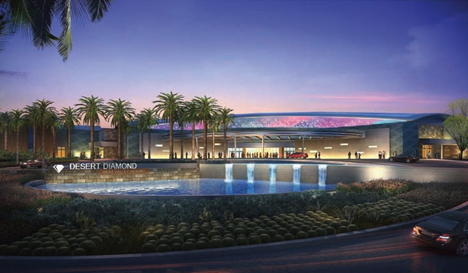
Completion of the Desert Diamond West Casino in Glendale, Arizona proceeded despite the Covid 19 pandemic
Tule River Tribe introduces HBG Design as Architect & Interior Designer for new Eagle Mountain Casino
See full article in The Porterville Recorder
After breaking ground for its new casino located in Porterville last week, Eagle Mountain Casino is fast moving forward with the development of the casino.
The relocation of the casino to 40 acres of land located just south and adjacent to the Porterville Sports Complex has been 25 years in the making. The new casino will feature 1,750 slot machines, numerous table games, a 2,000-seat event center and restaurants throughout the 100,000 square foot property.
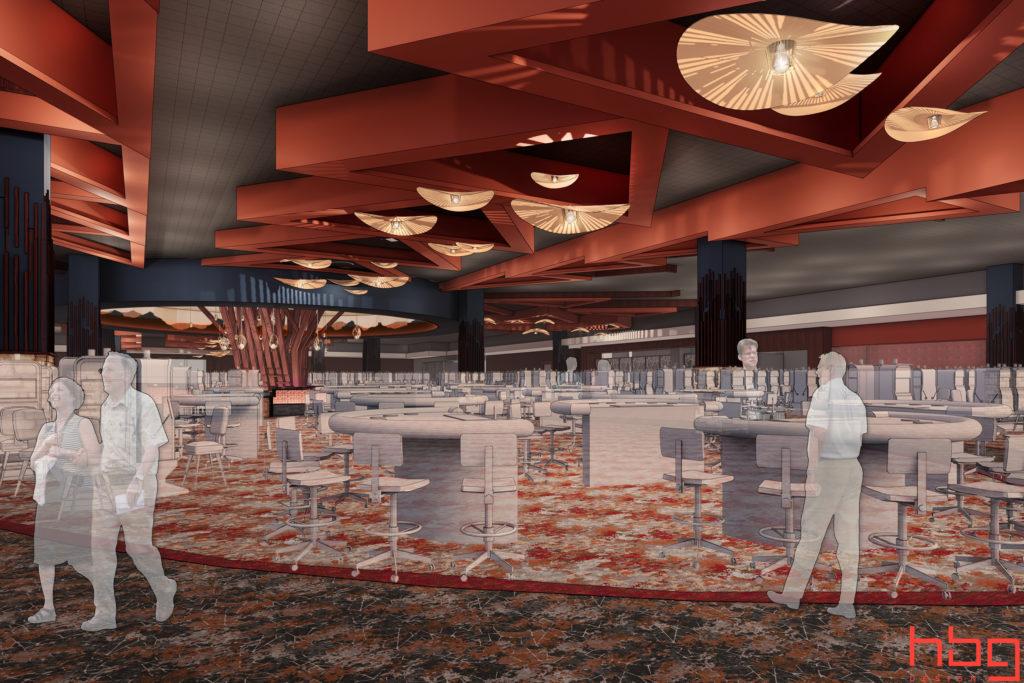 The relocation of the casino will free up water now being used by the casino for tribal members. The current casino will also eventually be used for additional medical facilities.
The relocation of the casino will free up water now being used by the casino for tribal members. The current casino will also eventually be used for additional medical facilities.
Nearly 200 people attended the groundbreaking including the Tule River Tribal Council, tribal members, Eagle Mountain Casino staff and many local dignitaries and political leaders. The ceremony began with a welcome from General Manager, Matthew Mingrone, followed by the presentation of colors by the Tule River Native Veterans Post of 1987 and a prayer and song by Tribal Elders J.R. Manuel, Rhoda Hunter and Tamara Seylaz.
 Honorable Tribal Speakers included: Tule River Chairman William Garfield, Vice-Chairman Neil Peyron, Councilman Felix Christman and Executive Director and Project Manager Ralene Clower. Honored Speakers included Congressman Kevin McCarthy, Senator Alex Padilla, Senator Shannon Grove, Assemblyman Devon Mathis, District Attorney Tim Ward, Tulare County Sheriff Mike Boudreaux, Porterville City Mayor Monte Reyes, National Indian Gaming Chairman Ernie Stevens, and Bureau of Indian Affairs Regional Director Amy Dutschke.
Honorable Tribal Speakers included: Tule River Chairman William Garfield, Vice-Chairman Neil Peyron, Councilman Felix Christman and Executive Director and Project Manager Ralene Clower. Honored Speakers included Congressman Kevin McCarthy, Senator Alex Padilla, Senator Shannon Grove, Assemblyman Devon Mathis, District Attorney Tim Ward, Tulare County Sheriff Mike Boudreaux, Porterville City Mayor Monte Reyes, National Indian Gaming Chairman Ernie Stevens, and Bureau of Indian Affairs Regional Director Amy Dutschke.
Tule River Tribal Vice Chairman Neil Peyron said during the ceremony, “This casino has been a long time coming. It's more than just a casino. This is education for our children, housing for our elders, and medical care for members of the tribe," Peyron said.
Boudreaux also announced at the groundbreaking the Tulare County Sheriff's Office would be the agency providing law enforcement for the casino.
Design Firm HBG Design and Construction firm W.E. O-Neil were the firms chosen by the tribe as construction begins this month.
HBG Design clients across the U.S. include more than 45 Indian gaming enterprises, and Commercial hospitality and entertainment giants such as Caesars Entertainment, Hyatt Hotels, Hilton Hotels and Elvis Presley Enterprises. HBG Design was recognized as an Associate Member of the Year by the National Indian Gaming Association for its support of Indian gaming tribes and Native American education programs. Visit www.hbg.design for more information.
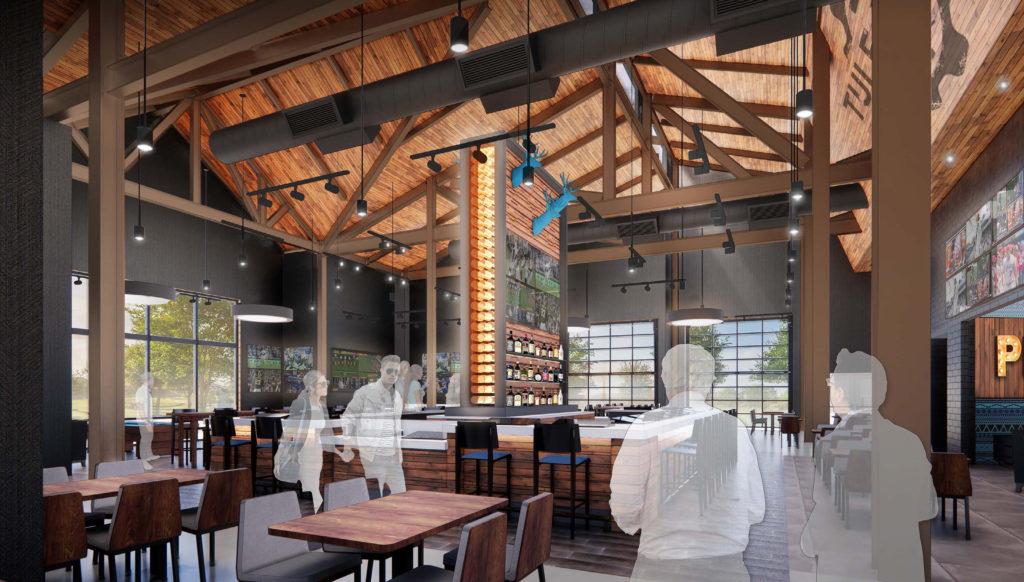 HBG's Joe Baraffaldi said the new casino's design will include Tule River heritage. The Sequoia tree canopy, trunk and roots of the Giant Sequoias are a main conceptual design of the casino.
HBG's Joe Baraffaldi said the new casino's design will include Tule River heritage. The Sequoia tree canopy, trunk and roots of the Giant Sequoias are a main conceptual design of the casino.
Baraffaldi said the Tule Tribe has been receptive to incorporating all of Tulare County's and Central California's cultural elements into the design. Artwork of the Tule River Tribe's native traditions will also be featured.
“Soaring vertical features will recall the majesty of the Giant Sequoia and the Golden Eagle,” Baraffaldi said, adding the Tule River will also be featured in the design.
A variety of tribal basket patterning will also be featured.
“Patterns and motifs of tribal symbolism will help draw guests through wayfinding paths, to the casino, the center bar, the dining venues and to ancillary spaces,” Baraffaldi said.
The Flight of the Butterfly will be featured at the entry and a mountain silhouette design that emulates the regional landscape will also be featured. The center bar will symbolize the idea of the fire as a place of gathering.
Casino guests will be welcomed with water features and a replica of the iconic tribal Painted Rock and Bigfoot pictographs found on Tule River Reservation lands.
The casino will feature a sports bar, food court and steak restaurant. With COVID safety measure in mind, instead of a buffet the casino will also feature a three-meal restaurant.
“We were able to create a new dining concept that will be even more comfortable and welcoming for patrons,” Baraffaldi said.
There's also been a investment in a premium air system. “The new casino is clean and safe for guests,” Baraffaldi said. “There are more robust safety elements designed into the new facility versus what an existing casino could provide.”
The casino is expected to open in December, 2022.
MBJ SWOT: HBG Design's innovation could pay dividends for its clients after COVID is over
See full article in Memphis Business Journal
by: Susan Ellis
Local economies are no different from organizations when it comes to taking stock of their ability to grow, innovate and thrive in lockstep with the times. Much depends on talent within: the employees of companies and nonprofits, the entrepreneurs who define a business community. But a lot also rides on the unique mix of ingredients that both define the local economy in question and play an outsize role in its success in navigating change or crisis. The SWOT analysis is nothing new for anyone familiar with business-school dogma, though its application to our small business community — as it rebounds from a pandemic — is probably a first. What follows is a breakdown of the strengths, weaknesses, opportunities and threats working for or against the region’s small-business owners as they climb back from one of the most economically and socially disruptive events in modern times.
MBJ SWOT: Weakness: Solutions when ‘all in’ might mean betting your life
One point the pandemic proved over and over again: The human body and economy are both highly susceptible to dramatic external forces like contagions, and the health and well-being of the first is inextricably linked to the ultimate success of the latter. When COVID started, Memphis-based HBG Design hit the drawing board to create solutions for its clients in the hospitality industry, whose revenue depended on the safety and confidence of customers. Their resulting innovation, Safebet, could continue to pay dividends long after COVID is gone.
HBG Design
Rick Gardner of the architecture/design firm HBG Design considers himself a “creative problem solver.”
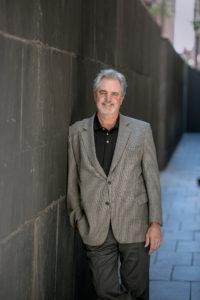
So, when the pandemic hit, he assigned his team to answer two questions: How will this pandemic affect business? And, how will it affect the way they approach design?
HBG specializes in work in the hospitality sector. Past projects include the Guest House at Graceland in Memphis and the Desert Diamond West Valley Casino in Arizona.
“We zeroed in on specific solutions,” he said. “We asked ourselves a very specific question that became the mission statement for Safebet: How do we make sitting on a stool in front of the slot machine the safest place on the gaming floor?”
Since games on the casino floor are often rearranged, the Safebet system is designed to work on all sorts of configurations — rows, carousel, and trios.
“The reason we zeroed in on [slot machines] as opposed to other places in the casinos is the slot revenue is the engine that drives resorts,” Gardner said.
In designing Safebet, HBG also considered user experience.
“Most people are uncomfortable with the way things were before the pandemic, sitting down next to a stranger in close proximity,” he said.
He noted that the walls can be removed for guests who want to play together on the machines.
HBG hooked up with manufacturing firm KGM Gaming to make the components of Safebet. That firm will also do the sales and marketing, while HBG will focus on R&D.
Gardner said there may be other applications for Safebet as well.
“We’ve focused first on the gaming side of things, but we’re looking at dining rooms for restaurants,” he said.
Gardner said that while many restaurants already use plexiglass, he envisions bringing that to a more “sophisticated” level. He pictures Safebet in convention centers and resorts. The average slot machine costs $20,000, Gardner said, with large casinos having roughly 1,500, for a total expenditure of $30 million. Something like Safebet could be a smart investment — not just for now but for the future.
“We’ve had all kinds of viruses and pandemics in the past 20 years — SARS, MERS, and all that stuff. And they came and went,” Gardner said. “But, [COVID-19] has affected us much differently. It’s been imprinted in our psyche. We’re not going to forget it. What we all know now is that there’s going to be something next.”
GGB Magazine Spotlights SAFEBET: An Industry Game-Changer During COVID and Beyond
See Full Article in Global Gaming Business Magazine
Here’s a new twist on safety in numbers.
For the casino world, it means that without safety, there are no numbers. The gaming industry, aided by sharp vendors, enters a safety age exceeding hand-sanitizing stations, Plexiglas shields and social-distance markers.
At relatively breakneck speed, vendors have unearthed products integrating safety and finance. The advancements look so creative they may also help the country leave the Covid-19 era. Other innovations are psychological, as in the engagement between companies and patrons via social casinos and their marketing vehicles.
Once the Covid-19 era recedes—and it will—analysts may recall this time as the industry embracing unprecedented ingenuity.
Bet on Safety
HBG Design is well-known for building great structures, but when the pandemic hit, the company geared efforts toward protecting them.
Enter SafeBet, a solution geared to the epicenter of the casino economic engine, the slot floor. From a health standpoint, it’s almost a luxury super box.
A Plexiglas component, which can help prevent someone from being sneezed upon, is joined by an air-filtration system that catches small droplets. There are also partitions between stations. A player can be in the middle of the action while retaining personal space.
Rick Gardner, AIA, CEO, principal and practice leader for HBG, says the company began designing this solution last April, as the pandemic was closing casinos and halting projects. Its solution targets both the current and perceived post-pandemic environments.
“We immediately started thinking about making casino gaming safe in the face of Covid-19, but a few months into the spring we quickly realized this is a different kind of pandemic, with a lasting impact unlike anything the world has experienced before,” Gardner asserts.
“I’m an optimist at heart, but there will be something else post-Covid affecting public health even after we get vaccines in arms and achieve herd immunity. Even if we’re just talking about the human psyche, we are forever changed. Will anyone want to sit shoulder-to-shoulder at a slot bank ever again? We don’t think so. Human behavior pre-Covid already favored physical separation between individuals.”
Why not embrace it? The safety measures enable people to play, but the concept can also be used for exclusivity, especially for high-limit games. Any operator able to manage this may turn survival into revival.
 Here’s how it works:
Here’s how it works:
Air from the indoor casino environment enters SafeBet through the intake grill, designed low to draw less smoke-laden air than air found in the upper reaches of a typical casino floor. As the indoor casino air enters the SafeBet intake grill, it is propelled by a recirculating fan through a patent-pending, ultraviolet-C lamp fixture custom-designed for SafeBet.
The indoor air is cleaned via two proven filtration systems. They are UVC radiation, designed to kill any viruses, bacteria or mold spores by exposure to ultraviolet light; and needle point bipolar ionization, which attracts air particulates like a magnet, stopping them in their tracks before proceeding to the supply air in the breathing zone.
The distribution of ionized air is introduced evenly into the breathing zone at a low velocity into the SafeBet station at the approximate height of an average person’s head/nose/mouth, providing a clean, particulate-free air supply to the guest.
“I think one of the key differentiators of SafeBet as a Covid product is that it’s not what you typically think of first,” Gardner says. “When I think of Covid products, my mind goes to jumbo-size hand sanitizer pumps, face masks, washing hands, etc., more in the PPE realm. I also think about the Plexiglas partitions that were initially installed as temporary fixes.
“So, when I think of SafeBet as a Covid product, it represents more of a design enhancement that solves customer safety challenges, but you honestly can’t even tell it’s a Covid product. That’s part of the beauty and ingenuity of it.”
Gardner says HBG wanted to create a long-term solution to innovate, adapt, research, design and build a product that not only addressed the critical needs of its customers now, but anticipated the future.
Gardner says SafeBet will be a difference-maker between casinos. HBG is collaborating with its manufacturing and distribution partner, KGM Gaming of Philadelphia, to take the product to the market, initially through existing casino clients who represent first adopters. A prototype is available to explore and experience in KGM’s Philadelphia showroom.
HBG expects to have initial installations in place in the first quarter of 2021.
“Casino customers have a choice in where they want to go and play, and by and large they gravitate to slot machines,” he says. “When a customer experiences the choice of gaming in a SafeBet station, we believe their time on machine will actually increase, and the stations themselves will generate more play.”

